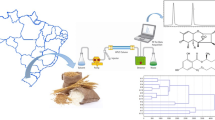Abstract
The fungal flora of wheat flour and baladi bread in upper Egypt were investigated. Most of the isolated fungal species belong to the genus Aspergillus. The presence of non heat resistant fungi of the both flat surfaces of baladi bread, came from contamination after baking and from improper handling at homes. Among the heat resistant fungi, A. fumigatus and A. niger, were recorded to inhabit the spongy crumb although the high temperature of baking process which reached approximately 100 ° C in the center of the bread.
The mutagenic effects of the fungal metabolites of the extract of mouldy bread was investigated. Several kinds of aberrations were observed in all stages of mitotic division. The most interesting effect of these fungal metabolites were the induction of tripolar and quadripolar spindle. Multinucleate and polyploid cells were also observed under relatively high concentrations. It was noticed that at either higher concentrations or lower concentrations with long exposure, damaged cells were observed. The hazards involved through the consumption of individuals to such mouldy bread, is accumulation of possible deleterious effects from both long and short term exposure to these toxic metabolites.
Similar content being viewed by others
References
Charles, P., Grost-Allman & P. S. Steyn, 1979. Structural elucidation of the nigerones, four new naphthopyrones from cultures of Aspergillus niger, J.C.S. Perkins I: 2474–2479.
Darlington, C. D. & L. F. Lacour, 1969. The handling of chromosomes. Georg Allen and Unwin Ltd., London.
Debeaupuis, J. P. & P. LaFont, 1978. Fumitoxins new mycotoxins from Aspergillus fumigatus fresh. Appl. and Environ-Microbiol.: 8–10.
Eigesti, O. J. & A. P. Dustin, 1955, Colchicine in agriculture, medicine, biology, and chemistry. Iowa st. college press, Ames, Iowa, USA
Giminez-Martin, G., 1968. On the triggering of mitosis and the division cycle of polynucleate cells. Chromosoma (Berl.) 25: 282–292.
Osborn, B. G., 1979. Reversed-phase high performance liquid chromatography determination of ochratoxin A in flour and bakery products. J. Sci. Fd Agri. 30: 1065.
Reiss, J., 1975. Mycotoxins in foodstuffs. V. the influence of temperature, acidity, and light on the formation of aflatoxins and patulin in bread. Eur. J. Appl. Microbiol. I: 183.
Reiss, J., 1976. Mycotoxins in foodstuffs. VI. formation of sterigmatocystin in bread by Aspergillus versicolor. Z. Lebensmittel Unters M-Forsch. 160: 313.
Reiss, J., 1977. Formation of moulds and mycotoxins on bread and bakery products. Getreide Mehl Brot. 31: 268.
Richard, J. C., J. W. Kirksey, J. W. Dorner, D. M. Wilson & J. C. Johnson, 1977. Mycotoxins produced by Aspergillus fumigatus species isolated from moulded silage. J. Agri. Food Chem. 25(4): 826–830.
Richardson, E. A., P. J. Flude, D. S. P. Patterson, D. W. R. Mackenzie & E. H. Wakefield, 1978. Ochratoxin A in retail flour. Lancet, 1366.
Spicher, G., 1970. Research into the occurrence of aflatoxins in bread. Zentbl. Bakt. parasitkde II, 124: 697.
Swanson, C. P., 1965. Cytology and cytogenetics. London, MacMillan and Co. Ltd.
Torrey, G. S. & E. H. Marth, 1977. Isolation and toxicity of moulds from foods stored in homes. J. Fd Protn 40: 187.
Tyllinen, H., M. Raevuori, E. Karppanen & A. S. Garry-Anderson, 1977. A study on the toxicity of spontaneously molded bread. Nord. Vet. Med. 29: 546.
Ueno, Y. & K. Fukushima, 1968. Inhibition of protein and DNA-synthesis in Ehrlichascetes tumor by nivalenol, a toxic principle of Fusarium nivalegrowing rice. Experientia, 24: 1032–1033.
Yamazaki, M., H. Fujimoto & I. Kawasaki, 1980. Chemistry of tremorogenic metabolites. I. Fumigtremorgin A from Aspergillus fumigatus. Chem. Pharm. Bull. 28(1): 245–254.
Yamazaki, M., K. Suzuki, H. Fujimoto, I Akiyama, U. Sankawa & Y. Litaka, 1980. Chemistry of tremorogenic metabolites. II. Structure determination of fumitremorgin B, a tremorogenic metabolite from Aspergillus fumigatus. Chem. Pharm. Bull. 28(3): 861–865.
Author information
Authors and Affiliations
Rights and permissions
About this article
Cite this article
Megalla, S.E., Abdou, R.F. & Bagy, M.M.K. Fungal flora of Egyptian baladi bread with special reference to the mutagenic effects of their toxic metabolites. Mycopathologia 89, 35–41 (1985). https://doi.org/10.1007/BF00437130
Issue Date:
DOI: https://doi.org/10.1007/BF00437130




